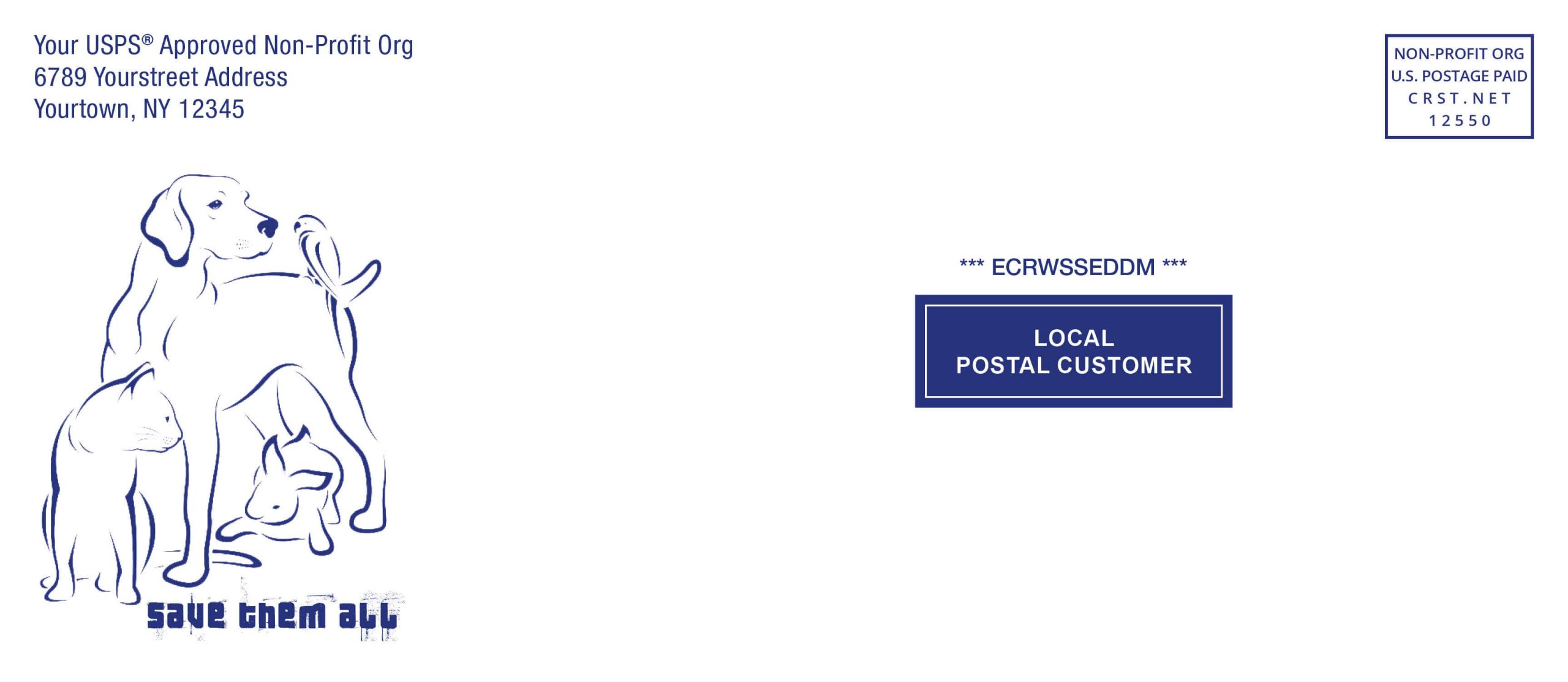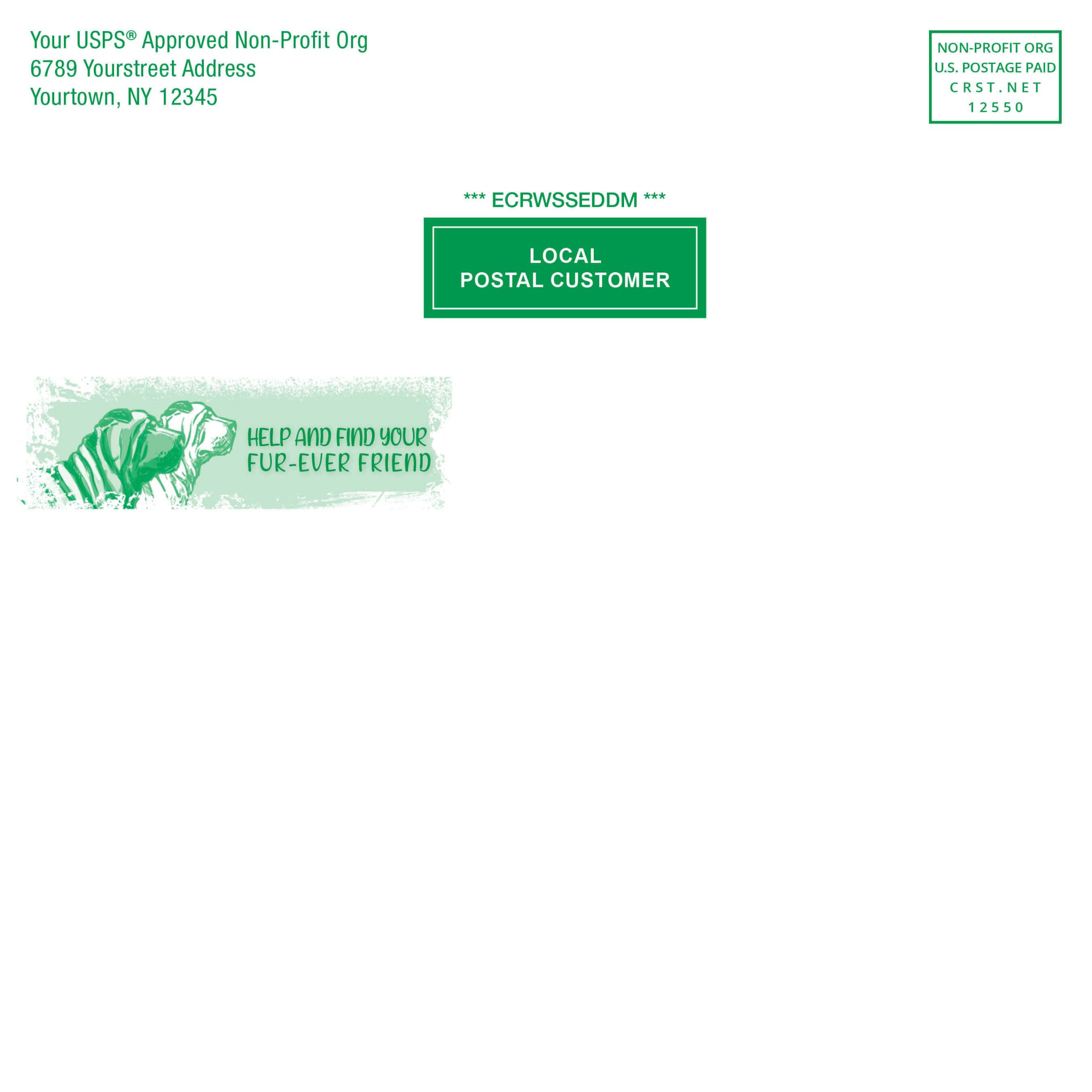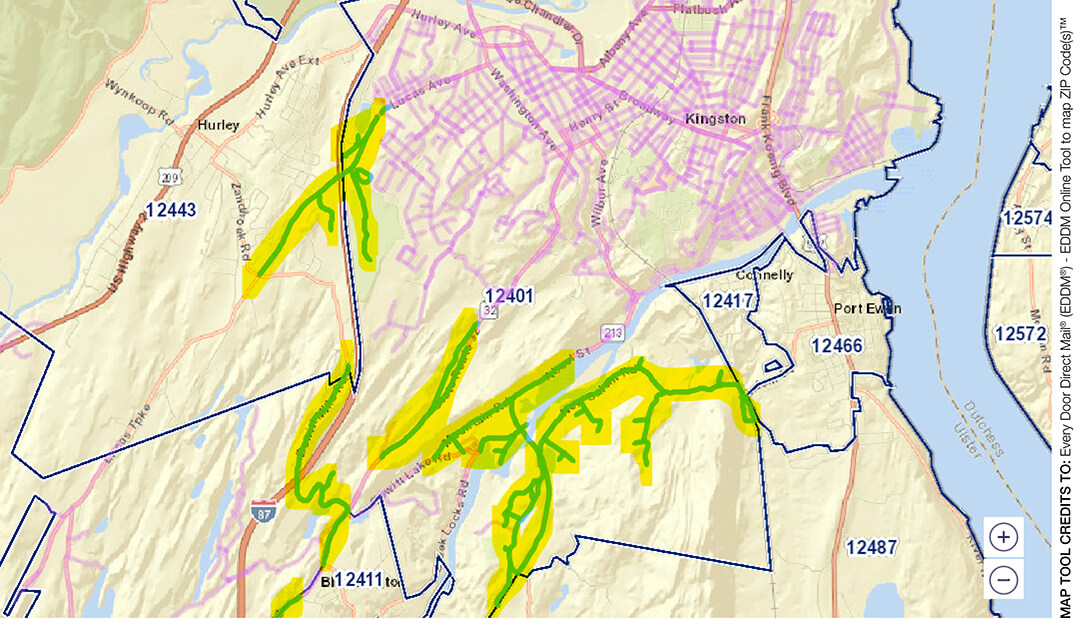Fundraising using EDDM® – Good or Bad Idea?

You don’t generally see Every Door Direct Mail® (EDDM®) flat-rate being used for not-for-profit appeal mailings, and you might wonder why that is? Even if your organization lacks formal USPS not-for-profit authorization – perhaps because it doesn’t have a qualifying IRS 501(c)(3) incorporation designation – the commercial rates are still pretty attractive around 20 cents per mailpiece (as of Jan 2024) for local postal entry. This write-up will help you explain the pros and cons of using EDDM® for fundraising.
Most not-for-profit organizations that periodically raise funds send appeal letters sent at not-for-profit Letter rates (#10 regular or window envelopes) is generally how it’s done. The non-profit rates are very attractive and can get as low as just over 11 cents, meaning that the delivery part of the acquisition costs are exceptionally low. Larger charitable, philanthropic, or educational entities either have their own donor lists, or they may rent a list (if not co-mingle lists) and then send out an appeal once or twice a year. The US Postal Service®, at no charge, has a relatively simple application process to allow qualifying, incorporated non-profit groups to obtain such discounted mailing rate privileges. These steps to apply are fairly simple, as shown here: How to Complete the Non-Profit Mailing Application.
So Why Do Some Groups Even Consider EDDM® for Fundraising?
However, there are some organizations that for various reasons may not follow a conventional non-profit mailing approach. Yours may be one of them. Let’s look at some scenarios that might make commercial EDDM® fundraising seem attractive:
You are Part of an Unincorporated Association: if your non-profit organization is technically not incorporated or is so new that it hasn’t gotten around to qualifying. For example, we have done work for Police Benevolent Organizations and Neighborhood Associations that have been “around forever”, but actually never went through the process of getting an IRS 501(c) designation as required by the USPS® for not-for-profit rates. Here, a commercial EDDM® approach starts to look fairly attractive.
Organizational Ineligibility: the PS 3624 application form is very direct: “Not all nonprofit organizations are eligible for the Nonprofit USPS Marketing Mail prices.” Here are some examples of not-for-profit organizations that typically do not qualify for non-profit rates: rural cemeteries, and social service organizations (Lions Club, Kiwanis, county political committees, informal church groups, social groups, chambers of commerce, etc.). Yes, it’s odd for some community service organizations not to be eligible while other groups amazingly qualify for such rates (think college fraternities or sororities). To get around this, groups such as Kiwanis smartly establish a not-for-profit arm of their organization, such as the Florida Kiwanis Foundation which has a specific intent on funding children’s programs.
IRS Status Issues: we have had several fire departments and not-for-profit organizations not be able to get their paperwork properly straightened out with the Internal Revenue Service. Interestingly, in each instance, the IRS status issues arose not because they “just happened” but because new volunteers took over and realized that there were either misincorporation problems (prior Treasurer incorporated the organization incorrectly), missed IRS filing dates, or unresolved IRS questions that a prior officer didn’t share with the rest of the Executive Committee or organization. In each instance, the Board Chair or Treasurer inherited a mess and had to pause on a USPS® not-for-profit filing until all was reconciled in the eyes of the IRS.
“Pop Up” Groups: it could be that your organization only exists briefly to serve a very short-term need or a one-time situational problem-to-resolve, and doesn’t have time to get better established given its ephemeral purpose. If a community is trying to raise funds for a family that lost its home in a fire, then an EDDM® Retail (or similar) mailing might be worthy of consideration.
EDDM® Fundraising Envelope Sizes
EDDM® is usually associated with oversized cards/postcards for mailing. However, for a fundraising mailing, the sender would likely wish to consider a conventional mailing envelope within which there would be an appeal letter, return envelope or anything else relevant to the appeal. Most groups would just send a USPS® EDDM® qualifying card, but in doing so, you’re banking on either (a) your recipient only going online to a fundraising platform you set up (e.g. GoFundMe, DonorBox, Fundly, et al.) or even going to just a PayPal or Stripe.com page, or (b) recipients finding on their own return contribution envelopes to use to send back to you their contributions. Either way, you’re going to miss a percentage of the fundraising audience. Given this, it’s likely you would consider an EDDM®-friendly envelope size.
The EDDM® service requires that a qualifying mailpiece size must have at least one dimension greater than 10 1/2” in length or 6 ⅛” in height. The maximum size is 15” in length and 12” in height. In postal speak, this means that you need to send a flat-rate mailpiece. Therefore, a conventional #10 business envelope (sized 4 ⅛” x 9 ½”) won’t qualify. The only other business-sized envelopes that would qualify would be #12 and #14 sizes, yet the problem here with larger envelopes is that any charitable organization would need to factor in the additional larger-sized envelope cost. Although #14 size envelopes (5” x 11 ½”) are more common than the less available and smaller #12 envelopes, they are going to cost your organization more than #10 regular envelope charges. It is possible to use square envelopes, such as 7”x7”, 8”x8”, or 9”x9” sizes, but here again, such usual envelopes translate into unusually high envelope costs.
#14 SIZE ENVELOPE (NON-PROFIT):

#14 SIZE ENVELOPE (UNINCORPORATED COMMUNITY GROUP):

9”x9” ENVELOPE:

Bottom Line: While the postage is indeed less expensive, the total cost of the mailing likely goes up because of the non-standard envelope size, making an EDDM® approach for fundraising less attractive. Further, getting materials sized properly outside of a non-conventional 8 ½” x 11” envelope size also adds potential cost if for no other reason than the folding/inserting might have to be manually done and not machined.
Retail EDDM® vs. Non-Profit EDDM® Postage Rate Difference
As of January 2024, the commercial EDDM® fixed rate is 20.1 cents per mailpiece (for direct local entry at a local post office). This is quite low of course due to its saturation (“everyone-gets-one”) presentation, although there is no targeting select homes within the carrier route in a given ZIP Code.
Non-profit saturation flat-rate bulk mail can also be quite low, reaching an attractive now at 11.0 cents per qualifying mailpiece. However, if your organization does qualify for USPS non-profit rates, then it would be advantageous to use a regular #10 envelope and stick with Letter-rate mail where the local postage rate is only 11.2 cents. Here’s the math for a 5,000ct mailing a Commercial EDDM® vs. Non-Profit EDDM® vs. (approximate) Non-Profit Letter Rates:
Commercial/Retail EDDM® Saturation (local entry): 5,000ct x 20.1¢ = $1,005.00
Non-Profit EDDM® Saturation Flat-Rate (local entry): 5,000ct x 11¢ = $550.00
Non-Profit Letter Saturation Rates (local entry): 5,000ct x 11.2¢ = $560.00
So, given the additional envelope and printing costs, it’s likely that if you and your organization can find a way to attain USPS® non-profit rate privileges, then non-profit letter rates (which also do not have to be saturated!) will be your best value.
EDDM® Carrier Routes vs.Non-Profit Proximity Requirements
Reaching the ideal target audience is also important, but with an EDDM® saturation approach, it’s all or nothing with carrier routes; in other words, you don’t get to cherry-pick homes along the routes; and, you also can’t do partial routes. Additionally, some of the USPS® carrier routes look more like varicose veins or a dropped can of pain vs. an orderly, tight array of proximity addresses.
Example: using the USPS® EDDM® Tool, here’s a map of Rural Route 5 in Kingston NY 12401 – with the “RR05” delivery addresses along select streets in light blue (and further highlighted). These carrier-routed addresses are not bundled tightly along a contiguous path, as you might think – this one carrier route alone surprisingly borders five other ZIP Codes. This is neither good nor bad, yet depending upon the proximity and other outreach considerations, this distribution of addresses might not be in line with what your organization is attempting to achieve:


Credit: USPS.com
EDDM® Simplified Addressing vs. Personalized Addressing
With commercial/retail or non-profit EDDM® simplified addressing (e.g. “Local Postal Customer”), there is of course no personalization in the address. This is in contrast with traditional direct mail, letter-rate solicitations which typically have at least an addressed envelope if not a personalized appeal letter (e.g. “Dear Thurston and Lovey,”).
Conventional philanthropic fundraising wisdom is that personalization speaks to and appeals to most donors. And, there are statistics to back this up, as per the Data & Marketing Association. Briefly, some level of personalization will increase your returns. Even having the name/address alone on a mailpiece is thought to increase probabilities by almost 75% with a personalized letter increasing the likelihood of response by over 40%. And if you need a bottom line statistic on personalization, mailing industry specialist and author David Amor offers this statistic: “Personalized direct mail has a 6.5% response rate; that which isn’t personalized, only 2%.”
Nonetheless, if you have a highly compelling message, combined with a novel EDDM approach, then you may not need personalization. Simply, just be “eyes wide open” regarding your approach.
The ROI on Saturation EDDM® vs. Non-Saturation Targeting
Every Door Direct Mail® is, yes, “every door”, and is of course “mail”, but one could claim that it’s not direct. The challenge is that most target audiences for non-profit organizations (such as PBAs, Fire Departments, EMTs, Rescue Squads, Community Foundations, Children’s Homes, private schools, Scholarship Funds, etc.) are not constrained by ZIP Codes. Even school districts or school foundations often incorporate multiple primary and partial peripheral ZIP Codes.
US Data Corp. makes a simple blanket statement that, in general, EDDM doesn’t really work for mailing programs such as non-profit appeal mailings because the acquisition cost (i.e. the ROI) per customer is over 4 times when all costs (data, printing, mailing services, postage, etc.) are factored together.
One simple way to determine whether you should look at an EDDM saturation (commercial/retail or non-profit) optimal scenario is to “reverse-engineer” a prior year’s appeal and qualify the results. Ask yourself these questions:
“What’s the profile of my contributors?”
“What do my donors have in common?”
“Does it matter where the intended recipients live?
If you are fundraising to build a new addition to a local synagogue, then your donors have a certain religious affiliation let alone a probable organizational preference. More generally, if you are trying to get sponsors for rescue animals at a local animal shelter, it might make more sense to target regional dog or cat owners vs reaching “every door”. Often, a mere qualifier such as “minimum household income” is much more powerful than a standard EDDM® “current resident” or “postal box owner” address. At Cornerstone Services we would non-profits to contact us to have an “asking questions” approach. Since targeted mailings usually entail unique data sets, then a specific conversation about this would be in order prior to make any plans to reach “every door”.
Fundraising DYI vs. Hired Mailing Service: Post-Mailing Assessment
We have a past, regional example of a prospect – a library – who called for an estimate but chose instead to “do the mailing themselves” using an EDDM® fundraising approach. Several board members wanted to “save money” and not outsource the fund-raising because they thought it was “too expensive”. (And, certainly, I would agree that there are times when a DIY approach is best.) So, a library appeal malign was done via EDDM®. Here’s what happened:
The saturation flat appeal mailing card did indeed get successfully completed and properly presented to local Post Offices without the help of an outside service such as Cornerstone. However, we were told by someone on staff that there were some post-mailing realizations that perhaps should have been considered: (a) no secondary home-owners were reached, so “the people with money in New York City, Long Island or New Jersey who own homes here didn’t get the mail (note: reaching secondary homeowners is something that Cornerstone can uniquely do); (b) “we also hit people [with the EDDM® mailing] who were never going to give us $$$”, meaning that the library reaching hundreds of students in student housing, located on many of the carrier routes; and, as you can imagine, undergrad/graduate students do not statistically contribute significantly to local appeal mailings; and, (c) with no return envelope to included, “the take was probably down because people were only given the PayPal option”. From our experience, an organization will actually get a response with a donor appeal mailing using EDDM®, but it will be a limited one. The real cost here, therefore, was the opportunity cost. The acquisition cost may have seemed attractive, but what was “left on the table” was much more valuable.
Sean H. Griffin, CMDSM / MDP, is President of the New Paltz, NY-based Cornerstone Services, Inc. He is past president of national 501(c)(6) and (c)(3) organizations as well as past president of a regional chamber of commerce. For more information, please email us at info@crst.net or call (845) 255-5722.
